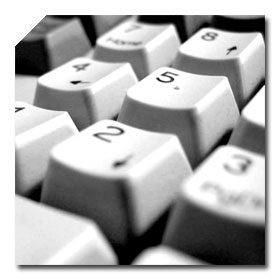
One limitation of the Taber Abraser (Abrader) is that the specimens must be flat and of a specific size. The following special test procedures demonstrate the versatility of the Taber Abraser:
Insulated Wire
Specimen: To prepare the specimen, an S-36-1 round mounting card is stripped of its protective overlay and placed on the E100-125 specimen holder. An abrading wheel cap nut is placed temporarily over the holder center screw to act as a guide. The specimen wire is wound in a clockwise direction, in a flat spiral, outward from the circumference of the guide to the edge of the holder. The cap nut guide is then removed and the coiled wire specimen, mounted on its holder, is placed against a flat surface and weighted with 5 pounds for 1 hour. The specimen holder clamp plate and E100-101 clamp ring are attached to the holder before the test begins.
a.) Insulation of Teflon with Glass Braid
Wheels and Load: CS-17 Calibrase with 1000 gram load
Evaluation: Visual end point, at the first sign that the wheels have worn through the insulation to the wire. Use of an electrical current to detect the end point automatically is suggested. One end of the specimen wire may be grounded and a soft wire tinsel brush, in contact with the wear path, conducted to a suitable electronic switch to stop the Abraser at a predetermined end point corresponding to the breakdown of the insulation.
b.) Rubber Covered Single Conductor Wire
Wheels and Load: H-22 Calibrade wheels with 1000 gram load
Evaluation: Same as Test A, above
Paste (Powder)
Specimen: Paste (i.e. toothpaste) or a paste made of powder and water, applied as a thin layer to acetate indicator plates
Wheels and Load: CS-0 or S-32 Calibrase with 250 or 500 gram load
Evaluation: By comparison of the number of wear cycles necessary to produce an equal degree of haze or scratching with that of a standard of identical material tested under identical conditions.
Paste / Powder / Liquid [*with the Multi-Media Attachment]
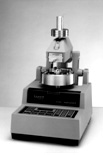 |
|
The Multi-Media Attachment is also available to evaluate particle abrasivity testing with the Taber Abraser. This option enables the user to recreate actual wear conditions for contact surfaces in application equipment, and is useful in predicting maintenance schedules. According to the manufacturer, applications include fluids, powders and semi-solids such as paints, pigments, adhesives, sealants, epoxies, detergents and industrial additives.
Another limitation is that the rub-wear action of the wheels may not provide the same wear mechanism as a product is exposed to in real-life. |
Three-Body Abrasion [*with the Grit Feeder Attachment]
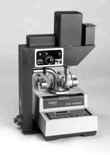 |
|
The Grit Feeder Attachment is used to evaluate three-body abrasion caused by the destructive action of fine hard particles. Similar to a falling sand tester, abrasive grit particles are deposited uniformly onto the specimen. The loose grit passes under a pair of leather wheels, and the resulting rolling action of the particles contributes to the physical breakdown of the material. |
Scuffing Abrasion [*with the Scuffing Head Attachment]
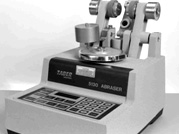 |
|
The Scuffing Head Attachment is used to evaluate damage caused by the scraping action of a special scuffing head. Used on materials such as vinyl, leather, non-wovens and painted products; two different weights and three scuffing head configurations are available. Type “A” is similar to the flat blade of a screwdriver (blade is approximately 8 mm wide). Type “B” has a knife edge (blade is approximately 4 mm wide). Type “C” has a radius edge (blade is approximately 8 mm wide). |
Other Instruments
If the Taber Abraser does not satisfy your test requirements, other instruments worth mentioning include:
Linear Abraser – Contoured Surface Testing
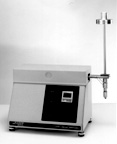 |
|
This instrument uses interchangeable attachments to perform abrasion, coin-scrape, scratch, mar, crocking, rub and other tests. With a splined shaft, the attachments become “free-floating” and follow the contour of the specimen as the stroke arm moves back and forth. To give the operator greater flexibility, Taber designed this instrument with adjustable stroke length, speed, and load. |
|
|